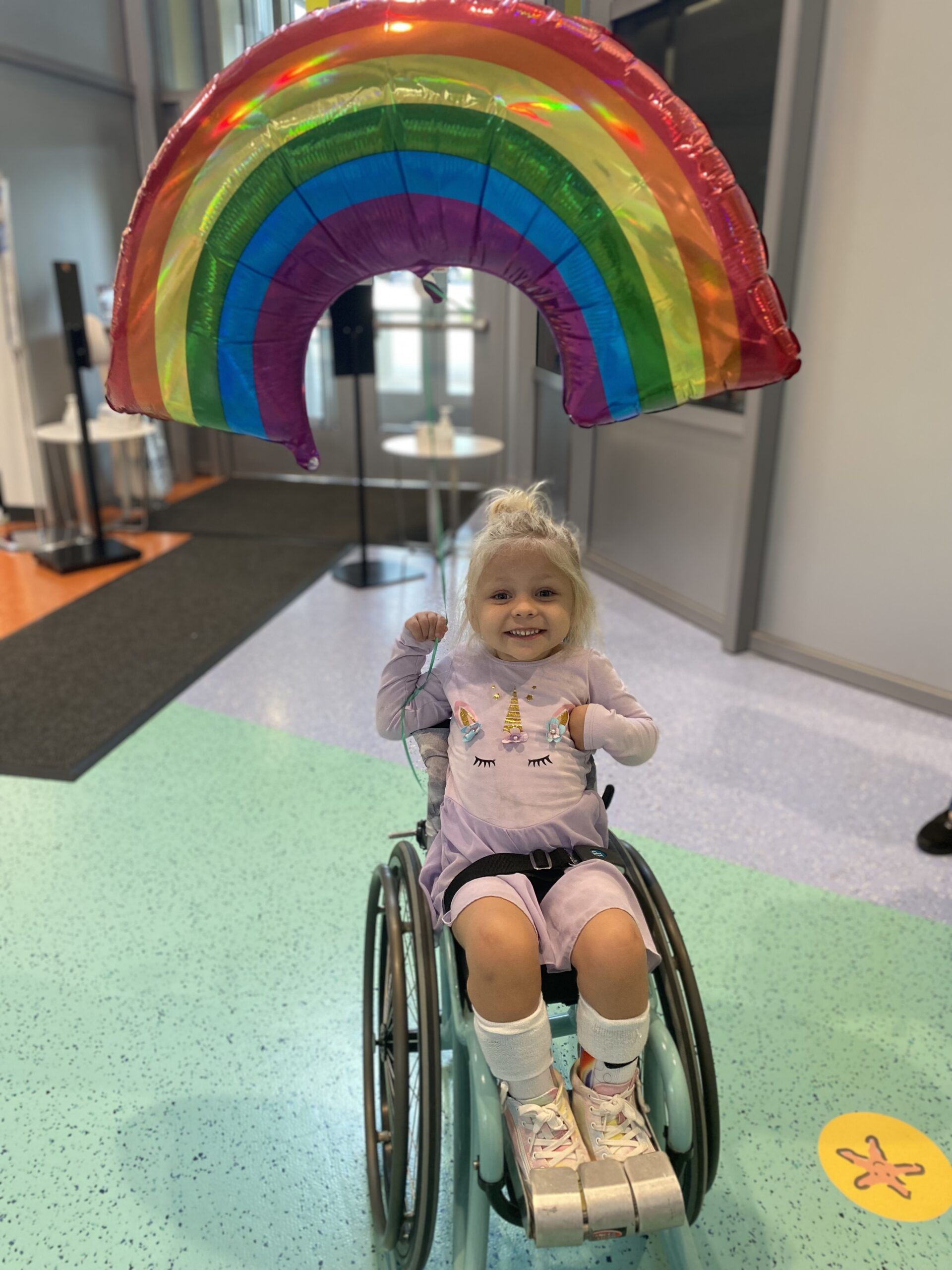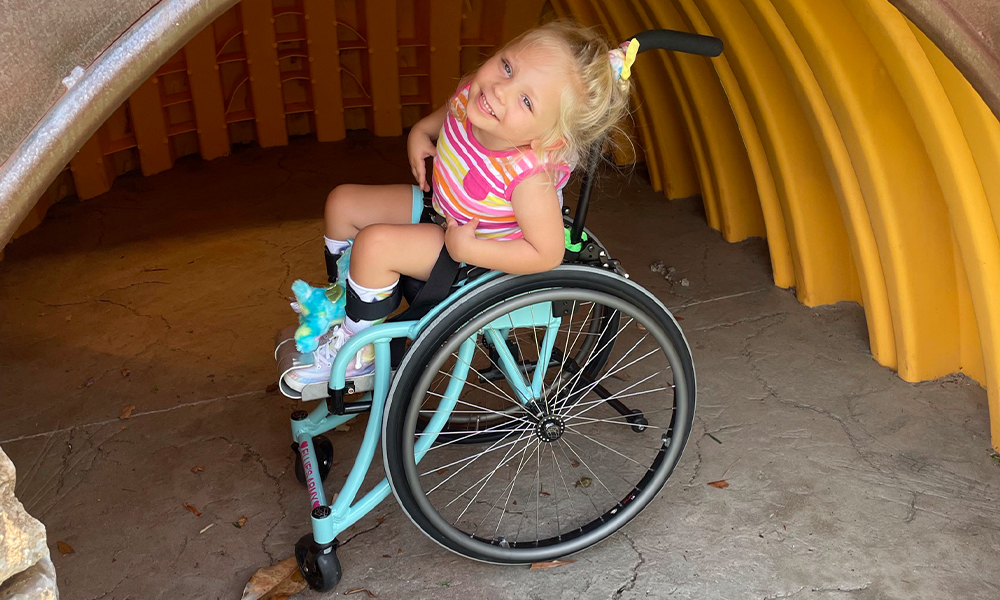Ellie Wilson was a typical active toddler at 16 months old. And then she wasn’t.
“She met all her milestones but then she started limping on her left leg,” explains Jill Wilson, Ellie’s mother. “Three weeks later, Ellie could no longer walk, stand or crawl. Within six weeks, she lost her ability to use her arms, too. It just came on so fast.”
At first, even specialists were puzzled about the cause but ultimately a brain MRI showed degeneration of the white matter in Ellie’s brain, a hallmark of a rare genetic disorder called Aicardi-Goutiéres Syndrome (AGS).
A type of leukodystrophy, AGS affects the brain, spinal cord, immune system and skin and is often more debilitating and progressive than cerebral palsy. Many kids with AGS have high tone, or muscle stiffness, in their extremities and low tone in their core, which makes AGS difficult to treat.
Only about 500 kids in the world have this inherited disorder.
When Ellie was finally diagnosed in 2018 at age 18 months, Jill learned all she could about the disorder and the treatments available.
With hope and determination in hand, the Wilsons, who live in South Carolina, traveled to the leukodystrophy center at Children’s Hospital of Philadelphia. There, the world’s leading expert on leukodystrophy was just launching a study of a drug that shows promise in slowing down the degeneration of white matter in the brain.
“It was perfect timing for Ellie to join the study,” Jill says. “When Ellie was first diagnosed, a doctor at a different hospital told us we just had three to five years with Ellie and tried to set us up with hospice. I didn’t like that answer. But the doctor in Philadelphia said she would never put a timeline on our child’s life.”
Ellie soon began therapy closer to home in South Carolina and has done a few intensive therapy programs around the country.
“When Ellie started therapy, she couldn’t even hold a cup,” Jill says. “With the combination of physical therapy and medication, she is making real progress.”
Jill continues: “AGS is technically a terminal, progressive disease. But there is not enough research out there and doctors don’t know enough about the disease. Ellie is defying everything we’ve been told. Some doctors said she would never talk but now the girl never stops talking. She is a typical 5-year-old girl except her legs don’t work. I think Ellie will be an independent adult someday. We’ve been super fortunate that Ellie has a milder case than many kids with AGS who are not verbal and have serious cognitive delays.”
 Ranken Jordan’s Unique Therapies and Equipment Speed Progress
Ranken Jordan’s Unique Therapies and Equipment Speed Progress
Because Jill recognizes the benefit of physical therapy for Ellie, she continues to seek out intensive therapy programs for Ellie. “There is not one best program—the different things each program offers are all beneficial,” she explains.
In the past year, Jill discovered a new outpatient intensive therapy program at Ranken Jordan Pediatric Bridge Hospital.
Erica Pfeiffer, PT, DPT, was Ellie’s physical therapist in South Carolina from the time Ellie was diagnosed. In early 2021, Pfeiffer moved back to her hometown of St. Louis and began working at Ranken Jordan.
This prompted Jill to begin researching Ranken Jordan. She discovered unique therapies and equipment not offered together at other programs around the country.
In July 2021, Jill and Ellie came to Ranken Jordan for two weeks of intensive therapy.
“Ellie went from two hours of therapy a week in South Carolina to 15 hours a week at Ranken Jordan—that’s a pretty substantial increase,” Erica explains.
When Ellie came to Ranken Jordan, she couldn’t hold herself up sitting with her back against a wall. When she left two weeks later, she could stand for 45 seconds without any help.
Ellie also struggled walking with a walker when she arrived. She could take a few steps but her feet got crisscrossed. By the time she went home, she could walk more than 100 feet and self-correct to put her feet in a better position for walking.
“Ellie’s progress is a testament to the impact therapy can have and all the specialized equipment we have here to help the tone dissipate and let the body do what it can do,” Erica says. “Ranken Jordan’s technology and the ability for Ellie to participate in so many things she was never exposed to in therapy made a huge difference for her.”
Ranken Jordan is home to the region’s only warm water therapy pool. The program also has
FES (functional electrical stimulation) bikes to stimulate muscles and vibration plates to relax muscles.
Jill says aquatic therapy and the FES (functional electrical stimulation) bike were part of what drew her to Ranken Jordan. “Ellie loved the pool and did so well because it relaxed her tone so she could walk and stand. Aquatic therapy helped Ellie feel free in the water. The pool had a big impact on Ellie’s progress.”
The warm water pool relaxes the muscles to help patients move through their range of motion. “It’s rare to have a warm water therapy pool in a hospital setting,” Erica says. “Some places may have a small tank but Ranken Jordan has a whole pool that gives us the space to do everything with the kids.”
FES bikes use electrical stimulation of the muscles. They also reduce muscle tightness. “We use FES to turn on the muscles needed to walk,” Erica explains. “It’s not common for places to have FES bikes so it’s exciting we have them here.”
Another benefit of therapy at Ranken Jordan are the vibration plates. These neuromuscular training tools relax the whole body and increase muscle function. The vibration plates reduced Ellie’s tone while also giving her relief from chronic constipation, which was a significant improvement for Ellie’s lifestyle and comfort.
“Ranken Jordan has things to offer that other intensive therapy programs don’t have, including the pool, FES bikes and vibration plates all in one location,” Erica says. “Only a few facilities in the country have all that. Ellie could do new things every day to make great gains.”
The Road to Independence
Ellie also enjoyed Ranken Jordan’s Mini Explorers, which are power mobility “cars” that allow kids to explore and gain independence.
“These are wonderful for kids who are not walking independently,” Erica says. “Research shows kids should start using power mobility devices around age 2 if they may need them in the future. It’s important from a cognitive and social standpoint and helps with motor planning and body awareness. It also gives kids the freedom and independence to zoom around to do what they want, which is important developmentally.”
Ellie had both physical and occupational therapy at Ranken Jordan. Jill was excited about the progress Ellie made in self-care.
“At Ranken Jordan, Ellie worked on a lot of life skills such as using the potty, wiping herself and pulling up her pants,” Jill says. “What she learned is sticking. The occupational therapy for self-care is new for us and has us thinking about how to adapt her room so she can be more independent.”
Jill was impressed by Ranken Jordan’s playful facility. “The facility is amazing. If we had a break, we could play on the indoor or outdoor playgrounds. Ellie loved going outside and going through the tunnel and swinging in her wheelchair. Plus St. Louis has many accessible parks, which is awesome.”
Because Ellie is still young, the hope is that therapy will help her brain “rewire” to compensate for the areas damaged by AGS, Jill says. “With repetition and therapy, we hope Ellie will be able to do more things on her own. We continue progress at home to find ways to help her be more independent by working therapy into everyday life and play. But I have to balance being a mom and not her therapist.”
 The Lasting Benefits of Intensive Therapy
The Lasting Benefits of Intensive Therapy
Ellie went home to South Carolina in July with therapy ideas for her local therapist to continue.
Jill plans to bring Ellie back to Ranken Jordan in about a year for a “refresh.” Ranken Jordan therapists will provide new treatment ideas based on Ellie’s progress.
“It’s like a tune up,” Erica says. “We teach kids things to do and then they go home to practice to keep progressing. When they come back, we create a new set of goals to work toward.”
Ranken Jordan frequently provides intensive bursts in therapy for patients with cerebral palsy, spinal cord injuries and traumatic brain injuries. “Through our intensive outpatient therapy program, we work with kids who are about to make a lot of progress or those who have plateaued and need a fresh approach,” Erica says. “There is a lot of research showing kids make more progress in short bursts and then live their life in between.”
Creating a Flexible, Affordable Intensive Therapy Program
Ranken Jordan’s outpatient intensive therapy program is designed for patients outside the St. Louis area who need higher intensity or frequency of therapy to meet their goals.
Patients may come for two to three weeks of physical, occupational and/or speech therapy at a frequency customized to their needs.
Many outpatient intensive therapy programs are difficult to get into because of strict schedules that may not always be accessible for working families. Jill appreciated Ranken Jordan’s flexibility.
“My husband and I both work so we were able to schedule therapy at Ranken Jordan when it worked best for us,” Jill says.
Erica agrees. “Other programs often have a set schedule with a specific block of time available and if you can’t make that work then you don’t get in. Our goal is to work around patient and family needs. We try to be as flexible as possible and adapt to patients and their goals. That may mean they come for intensive therapy three times a week for a month or every day for two weeks. We customize the program for each patient.”
Because insurance for out-of-state patients often doesn’t cover outpatient intensive therapy, Ranken Jordan’s program is cash-based. “The hourly rate for our intensive outpatient therapy program is more affordable than most programs,” Erica says. “And at Ranken Jordan there is always someone who will work with you and figure out how to make the program more accessible.”
Ranken Jordan helped make the Wilson family’s St. Louis stay easier and more affordable. A social worker referred them to a Ronald McDonald House, which dramatically reduced their expenses.
Jill says the cost of the Ranken Jordan program was about one-third of what it has cost to participate in other programs when travel, hotel and food expenses are added.
Outpatient intensive therapy is an elective treatment so it’s harder—insurance doesn’t cover it but it’s more doable at Ranken Jordan,” Jill explains. “It’s amazing that St. Louis has three Ronald McDonald Houses. There’s so much to do in St. Louis and Ranken Jordan has a great program that is a lot more feasible for families to do based on its flexibility and affordability.”
To learn more about enrolling in Ranken Jordan’s Outpatient Intensive Program, please contact our outpatient therapy office at 314-872-6440. The hospital offers a 20% discount when services are paid in full at the beginning of the course of treatment. We remain committed to keeping the pricing of this product within reach of as many families as possible.

